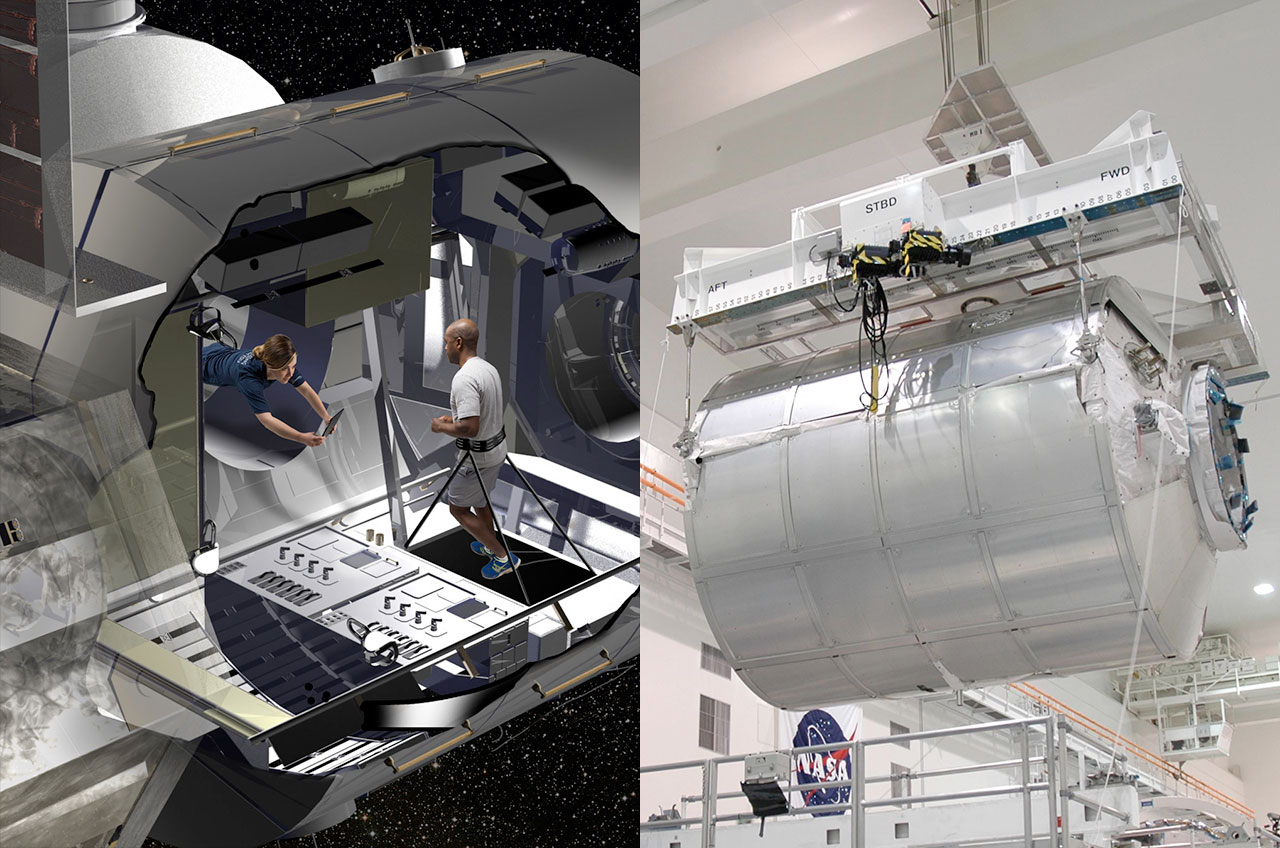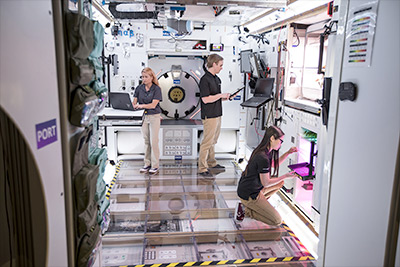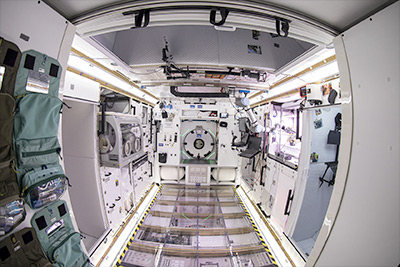|
|

|
|
Author
|
Topic: Lockheed Martin cislunar habitat (NEXTStep)
|
Robert Pearlman
Editor Posts: 50516
From: Houston, TX
Registered: Nov 1999
|
 posted 07-24-2017 12:00 AM
posted 07-24-2017 12:00 AM
   
collectSPACE Shuttle-era cargo module to become deep space habitat prototypeA cargo container that was built to fly on NASA's space shuttles is being repurposed as a prototype for a deep space habitat. Lockheed Martin announced it will refurbish the Donatello multi-purpose logistics module (MLPM), transforming from it from its original, unrealized role as a supply conveyor for the International Space Station to a test and training model of a living area for astronauts working beyond Earth orbit. The work is being done under a public-private partnership between the aerospace corporation and NASA.  |
SpaceAngel
Member Posts: 443
From: Maryland
Registered: May 2010
|
 posted 07-24-2017 10:39 AM
posted 07-24-2017 10:39 AM
   
Why was the Donatello MPLM never flown during the time of the shuttle flights to and from the ISS? |
Robert Pearlman
Editor Posts: 50516
From: Houston, TX
Registered: Nov 1999
|
 posted 07-24-2017 11:44 AM
posted 07-24-2017 11:44 AM
   
Donatello was more capable than Leonardo and Rafaello, with the ability to provide power to cargo that needed to remain continuously active. That feature though, turned out to be unneeded and so the MPLM went unused. |
SpaceAholic
Member Posts: 5246
From: Sierra Vista, Arizona
Registered: Nov 1999
|
 posted 08-18-2018 07:35 AM
posted 08-18-2018 07:35 AM
   
Lockheed Martin provided the Orlando Sentinel with a look at its deep space habitat prototype. At about 15 feet wide and nearly 22 feet long, the cylindrical capsule is roughly the size of a small bus. But it'll be a tight fit if four astronauts reside in it for 30 to 60 days, as Bethesda, Md.-based Lockheed envisions.The capsule is designed to house racks for science, life support systems, sleep stations, exercise machines and robotic work stations, said Bill Pratt, the program's manager. "You think of it as an RV in deep space," he said during a tour of the prototype. "When you're in an RV, your table becomes your bed and things are always moving around, so you have to be really efficient with the space. That's a lot of what we are testing here." |
Blackarrow
Member Posts: 3604
From: Belfast, United Kingdom
Registered: Feb 2002
|
 posted 08-18-2018 08:32 PM
posted 08-18-2018 08:32 PM
  
How much protection does it have against solar flares? |
Robert Pearlman
Editor Posts: 50516
From: Houston, TX
Registered: Nov 1999
|
 posted 08-18-2018 10:10 PM
posted 08-18-2018 10:10 PM
   
I believe most of the focus on this particular prototype is on the outfitting and layout of the interior. That said, some Lockheed imagery of its design has potable water and logistics stowage surrounding the habitable volume. Though the radiation environment at the moon is different, there is some precedent for adding exterior shielding to an MPLM. The Leonardo module was converted to the International Space Station's Permanent Multipurpose Module, which included using the multi-layer insulation blankets from the Donetello MPLM (now being used for Lockheed's prototype). NASA has also partnered with StemRad to fly the AstroRad radiation protection vest on Orion Exploration Mission-1 and to the space station to evaluate its use for crewed missions. |
Blackarrow
Member Posts: 3604
From: Belfast, United Kingdom
Registered: Feb 2002
|
 posted 08-20-2018 07:25 AM
posted 08-20-2018 07:25 AM
  
It's good to see that serious work is being done on radiation protection. I assume (in the near to medium term) there will not be adequate protection against major solar flares and that circumstances could therefore arise where a crew in a habitat beyond the Moon are exposed to a fatal radiation dose. That makes me think of the crews of sailing ships setting off across the Atlantic centuries ago: aware of the risk of being sunk by storms, but going anyway because you can't cower in your house throughout your life. Of course there is a significant difference: many crew members on those old sailing ships had been press ganged. The crews of Orion/habitat missions will all be volunteers, and the astronauts will be queueing up looking for seats! On edit: It also occurs to me that we can predict solar "weather" a bit better than 16th century sea-captains could predict Atlantic weather. |
Ross
Member Posts: 531
From: Australia
Registered: Jul 2003
|
 posted 08-20-2018 09:15 AM
posted 08-20-2018 09:15 AM
   
Solar flares are a problem but cosmic radiation is a far greater problem. While solar flares can be detected before they reach the spacecraft and thus the crew can evacuate to a safe area, cosmic radiation is constant and the entire living and working areas need to be protected. In addition some cosmic radiation is of much higher energy than the solar wind and is not stopped by materials that can protect from the constant part of the solar wind. Spaceflight has had a couple of articles in recent years pointing out that, as yet, there is no reasonable solution to the cosmic radiation problem. |
Robert Pearlman
Editor Posts: 50516
From: Houston, TX
Registered: Nov 1999
|
 posted 03-31-2019 04:48 PM
posted 03-31-2019 04:48 PM
   
Lockheed Martin release Returning Astronauts to the Moon: Lockheed Martin Finalizes Full-Scale Cislunar Habitat PrototypeNextSTEP Habitat Prototype to Support NASA's Gateway Architecture For long-duration, deep space missions, astronauts will need a highly efficient and reconfigurable space, and Lockheed Martin is researching and designing ways to support those missions. Under a public-private partnership as a part of NASA's Next Space Technologies for Exploration Partnerships (NextSTEP) Phase II study contract, Lockheed Martin has completed the initial ground prototype for a cislunar habitat that would be compatible with NASA's Gateway architecture. This habitat will help NASA study and assess the critical capabilities needed to build a sustainable presence around the Moon and support pioneering human exploration in deep space.  The full-scale prototype, or Habitat Ground Test Article (HGTA), is built inside of a repurposed shuttle-era cargo container, called a Multi-Purpose Logistics Module (MPLM), at Kennedy Space Center. Using rapid prototyping and modern design tools like virtual and augmented reality, the team customized the interior making full use of the entire volume of the module to accommodate a variety of tasks like science missions and personal needs of future astronauts. The team also studied how to apply the advanced, deep space capabilities that are already built in to NASA's Orion spacecraft. Through additional research and development funding, the NextSTEP team also applied mixed-reality technology to further refine the concept. "Throughout the design and engineering process of this high-fidelity prototype, we have kept the diversity of missions top-of-mind," said Bill Pratt, Lockheed Martin Space NextSTEP program manager. "By building modularity in from the beginning, our design can support Lunar orbit and surface science missions along with commercial operations, all while accelerating the path to the Moon." Over the past five months, the team used tools like virtual and augmented reality to simplify and streamline the build-up process. They also applied expertise from Lockheed Martin's heritage of operating autonomous interplanetary robotic missions, like OSIRIS-REx and InSight, to integrate reliable robotic capabilities in to the design.  "Getting back to the Moon, and eventually Mars, is no small feat, but our team are mission visionaries," said Pratt. "They have worked to apply lessons learned from our experience with deep space robotic missions to this first-of-its-kind spacecraft around the Moon." The Lockheed Martin team will soon transition the prototype to the NASA NextSTEP team for assessment. During the week of March 25, a team of NASA astronauts will live and work inside the prototype, evaluating the layout and providing feedback. The NASA test team will also validate the overall design and will be able to evaluate the standards and common interfaces, like the International Docking System Standard (IDSS), and how to apply those systems for long-term missions based at the Lunar Gateway. Once NASA testing has completed, Lockheed Martin will continue to optimize and study the prototype to prepare for other Lunar efforts. | |
Contact Us | The Source for Space History & Artifacts
Copyright 2023 collectSPACE.com All rights reserved.

Ultimate Bulletin Board 5.47a
|
|

|
 advertisement advertisement

|














